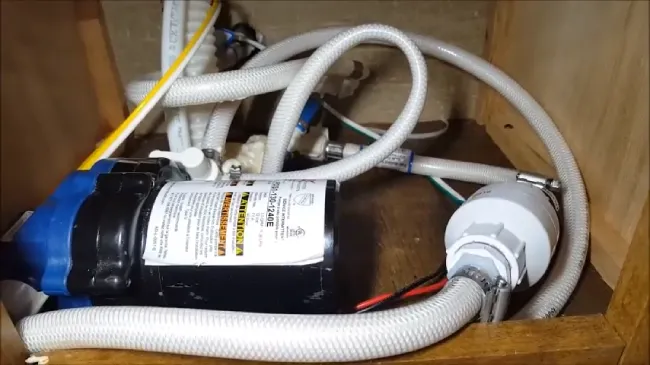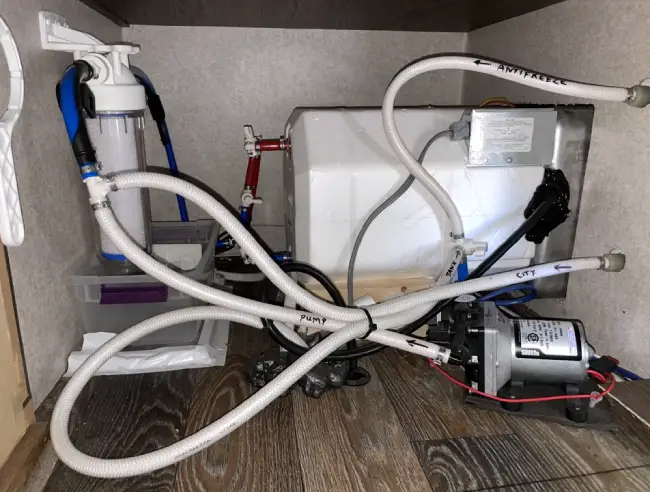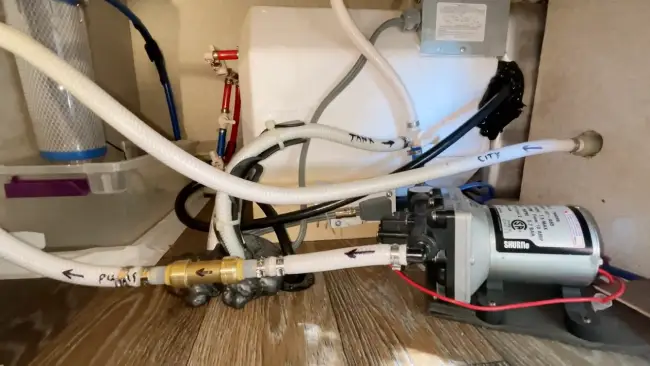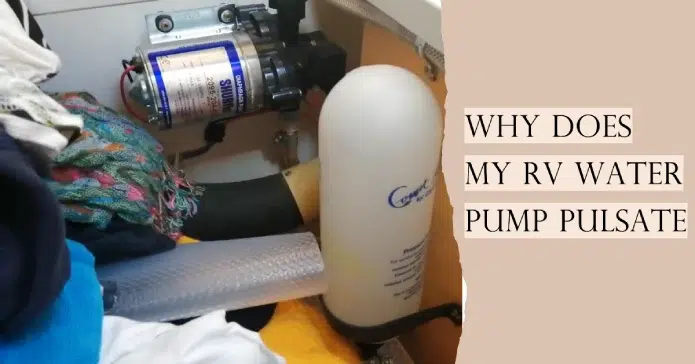Last Updated on June 26, 2023
Experiencing a pulsating water flow from your RV’s water pump could prove frustrating and ruin your camping experience. Several factors can cause pulsating water flow, so figuring out these problems is crucial.
There are many reasons for this problem, but the most common is a misadjustment or failure of the pressure sensor built into the RV water pump. The issue can also be caused by low water pressure, plumbing blockage, or RV plumbing leaks.
Today we’ll discuss why your RV water pump pulsates and how to fix it. So, if you want to solve this problem and enjoy a smooth water flow in your RV, keep reading.
Why Does My RV Water Pump Pulsate: Six Common Reasons

The following common reasons can result in pulsating water flowing from an RV water pump.
#1 Mis-Adjustment
An incorrect pressure switch adjustment is one of RVs’ most common reasons for pulsating water pressure. The pressure switch determines when the pump should turn on and off based on the water pressure in the system.
If it’s not set properly, the pump will turn on and off frequently, causing the pulsating water pressure you’re experiencing.
#2 Low Water Pressure
Another possible cause for this issue is low water pressure. This can occur due to clogged pipes, a faulty pressure regulator, or even a low water supply at the source.
#3 Pressure Sensor Failure
The pressure sensor regulates the water pressure in your RV’s water system. If the sensor fails, it can cause the water pump to pulsate. This pulsation happens because the water pump is not receiving a consistent water pressure signal from the pressure sensor.
#4 Leak in RV Plumbing
If you notice that the water pressure in your RV is lower than usual, there may be a leak in your RV’s plumbing system. This is a common issue that affects about 20% of RV owners. Leaks can occur in various system parts, such as the water pump, faucets, or pipes. Leaks can occur in various system parts, such as the water pump, faucets, check valves or pipes.
RV water pumps can have these valves. If the check valve fails, water may leak back into the tank, causing the pump to lose prime and start pulsating. Checking the check valve is crucial to ensuring proper water pressure in your RV’s plumbing system.
The best way to identify the leak’s location is to inspect the RV’s plumbing system carefully and look for any signs of water damage or wet spots. A pressure gauge can also be used to check the water pressure at various points in the system and see if there are any significant drops in pressure.
#5 Low Water Level
Now that we’ve discussed how a leak in your RV plumbing can cause your water pump to pulsate let’s move on to another possible reason: low water level.
When your RV’s water tank is low, your pump must work extra hard to pull water through the system. This can cause the pump to pulsate as it struggles to maintain a consistent water flow.
#6 Blockage in RV Plumbing
Blockage can make your RV’s water pump pulsate and create a frustrating situation during your camping trip. Several things, such as debris in the water tank or a clog in the pipes, could cause the blockage.
When there is a blockage in the plumbing system, the water pump has to work harder to push the water through, resulting in a pulsating water flow.
How to Fix an RV Water Pump Pulsate?

If you’re experiencing a pulsating RV water pump, don’t worry; you can try several solutions.
#1 Adjust the RV Water Pump’s Pressure Setting
If you’ve noticed your RV water pump pulsating, it may be time to adjust the pressure setting. Adjusting the pressure setting is fairly straightforward whether you have a Flojet, Shurflo, or Seaflo water pump.
Following a few simple steps, you can fine-tune your RV’s water pressure and enjoy a more consistent water flow while on the road.
A. Adjust Flojet Water Pump Pressure
Let’s crank up the pressure on that Flojet pump and say goodbye to those annoying pulsations.
To adjust the Flojet water pump pressure, remove the cover plate using a Phillips head screwdriver. Take note of the screw located between the two electrical connections.
Turn on your shower and then turn the screw clockwise to increase the cut-off pressure. After turning off the shower, check if the pump stops running. If it doesn’t, turn the screw slightly counterclockwise until it does.
That’s it. Now you can enjoy a steady flow of water without any pulsations.
B. Adjust Shurflo Water Pump Pressure
To do this, locate the housing at the end of your water pump where the pipe is connected and find the Allen screw.
Turn on your shower and use an Allen wrench to turn the screw clockwise until the cycling stops, making ¼ turns at a time as recommended by Shurflo.
Once you’ve done this, turn off the shower to test. If the pump won’t turn off, you’ve turned the Allen screw too far and need to back it off slightly by turning the screw counterclockwise until the pump stops.
C. Adjust the Seaflo Water Pump Pressure Setting
To adjust the Seaflo RV water pump pressure, head to the housing on the end of the pump where the water pipe is attached and locate the Allen screw with two wires. Turn on the shower and turn the pressure adjustment screw clockwise to stop the pulsating.
Test the pump by turning off the shower, and if it doesn’t shut off, turn the screwdriver slowly counterclockwise until the pump stops. This will ensure that the pump runs at the correct pressure, preventing any damage or issues with your water system.
#2 Use an Accumulator Tank
You’ll be amazed at how smooth and consistent your water flow will be once you install an accumulator tank on the pressurized side of your system. This tank uses an air bladder to maintain constant pressure, eliminating the pulsating water flow that can be frustrating.
Not only will it make your showers more enjoyable, but it will also protect your water pump from unnecessary wear and tear. Installing an accumulator tank is a simple process and can be done with basic tools. But if you’re uncomfortable with plumbing, it’s best to have a professional install it.
#3 Install a Pulsation Damper
Installing a pulsation damper is a simple way to enjoy smoother and more consistent water pressure in your RV. When your RV water pump runs, it creates pressure pulses that can cause the water to hammer and vibrate. These pulses can damage the water system and cause fittings to leak.
By installing a pulsation damper at the outlet of the pump, these pressure pulses are absorbed, and the water pressure becomes more even and steady. Pulsation dampers use a flexible diaphragm to separate the water from a compressed gas charge.
When water flows into the damper, the diaphragm compresses the gas charge, absorbing the pressure pulse. When the water flow stops, the diaphragm expands, pushing the water out of the damper.
This creates a more even water pressure and reduces the wear and tear on your RV water system. If you have tried using an accumulator tank and your RV water pump is still pulsating, installing a pulsation damper can help.
#4 Replace the Damaged Water Pump
If your RV’s water pressure is still uneven despite installing a pulsation damper, it’s likely time for a new pump. Water pumps in RVs can fail over time, just like any other mechanical part.
Replacing a damaged water pump is relatively easy but requires some basic knowledge and tools.
Is the RV Water Pump Pulsing Normally?

There’s no need to worry if you’re experiencing pulsing from your RV water pump. In most cases, it’s completely normal and nothing to be concerned about.
When the pulsing is particularly severe or damaging your plumbing, you should investigate it and figure out if there’s a problem with your water pump. Make your showers more enjoyable by protecting your water pump.
Is the Pulsing Bad for RV Water Pump?
Experiencing pulsing from your RV’s water pump may not be a cause for concern, but it isn’t causing damage to your plumbing system. The pulsing is simply caused by the pump turning on and off as it tries to maintain water pressure. While it may be annoying, it doesn’t harm the pump or your RV’s plumbing system.
If you want to reduce the pulsing and improve the consistency of your water flow, you can do a few things. First, make sure your water tank is full before using the pump. This will reduce the frequency at which the pump turns on and off.
Also, you can install a water accumulator or a pressure regulator to help smooth out the water pressure. While these solutions aren’t necessary, they can help make your RV’s water system more enjoyable.
Keep Your RV’s Plumbing Problem-Free with Proper Water Pump Maintenance
Although pulsation can be normal for some RV water pumps, it’s not ideal for longevity. Pulsation can cause the pump to work harder and wear out faster. The most common reasons for pulsation include air in the system, a faulty pressure switch, or a clogged filter.
Therefore, addressing the issue promptly is essential and ensuring your RV water pump is functioning correctly. Regular maintenance and inspections can prevent pulsation and other issues, ensuring your RV’s plumbing system runs smoothly and efficiently.
You may need to bleed the system, replace the switch, or clean or replace the filter to fix the issue. So, keep your RV water pump in top condition, and your adventures on the road will be worry-free.



